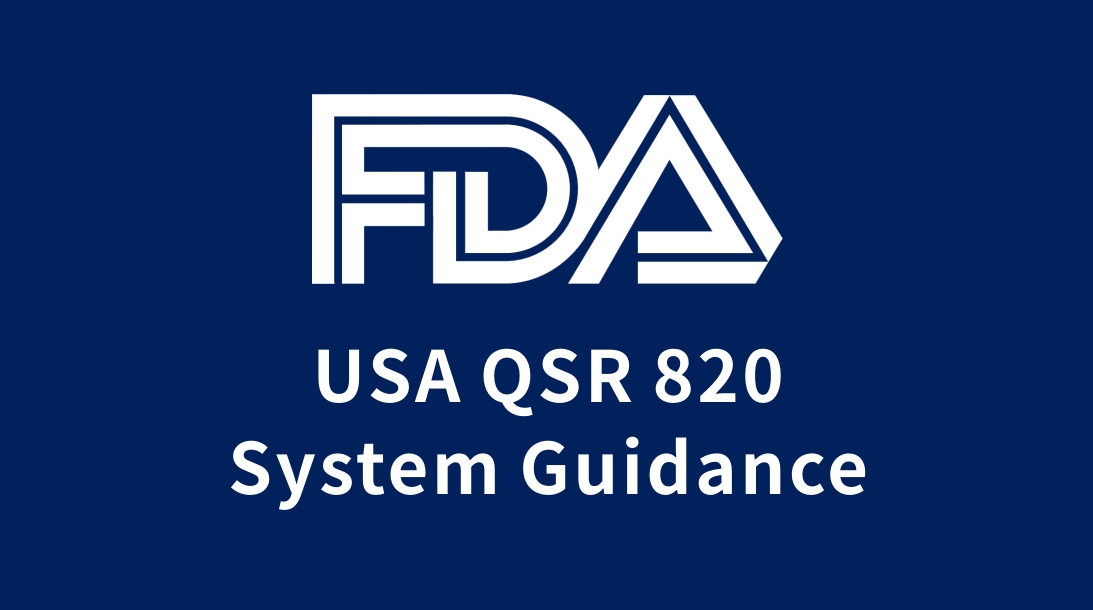The United States Medical device QUALITY SYSTEM REGULATION(QSR), also known as 21CFR820, is the English abbreviation of the United States medical device quality management system regulation. Because it is located in the Code of Federal Regulations 21 Part 820, it is referred to as QSR820. The Current QSR820 was promulgated on October 7, 1996, took effect on June 1, 1997, and was revised six times before and after, also known as the Current Good Manufacture Practice for the U.S. medical device industry. It is the quality management system regulations that American medical device manufacturers and overseas medical device manufacturers that intend to sell their products to the United States must comply with, and it is the basic requirements that most medical devices must comply with before listing in the United States and may be inspected by FDA authorities at any time after listing, this medical device factory inspection audit is usually called FDA factory inspection (FDA inspection).
The QSR820 Quality System specification describes the requirements of the Current Good Manufacture Practices (CGMP). This specification specifies the methods, facilities, and controls used in the design, manufacture, packaging, labeling, storage, installation, and service of all finished medical devices. These requirements are intended to ensure that finished medical devices are safe and effective and comply with the U.S. Food, Drug and Cosmetic Act. This specification sets out the basic requirements applicable to manufacturers of finished medical devices, and if a manufacturer performs only some of the operations specified in this Specification and no other operations, that manufacturer shall only perform those requirements applicable to the operations it performs. For Class I devices, design controls are performed only in accordance with the requirements listed in §820.30(a)(2). This specification does not apply to manufacturers of finished components and parts, but such manufacturers are encouraged to use the appropriate provisions of the specification as a guide. QSR820 consists of 15 chapters:
A. General Rules
B .Quality system requirements
C. Design control
D. Document control
E. Procurement control
F. Identification and traceability
G. Production and process control
H. Acceptance activities
I. Defective product
J. Corrective and preventive actions
K .Label and packaging control
L. Handling, storage, shipping and installation
M. Record
N. service
O .Statistical techniques
In general, QSR820 is a set of medical device quality management system regulations that are different from ISO13485 in structure and basically the same as ISO13485 in requirements, but more clear and more specific in provisions.
Who should comply with QSR820?
21QSR820.1 provides that all medical device companies in the United States and Puerto Rico, or have products exported to the United States and Puerto Rico, must establish a quality system in accordance with the requirements of QSR820. Companies can meet the provisions of the QSR related to their activities according to the actual situation.
QSR820 does not apply to manufacturers of medical device parts, but FDA encourages such companies to be guided by the provisions applicable in QSR820.
QSR820 does not apply to manufacturers of human blood and blood products, which should comply with the provisions of 21CFR606.
Who checks whether a business is compliant with QSR820?
FDA's Center for Devices and Radiological Health (CDRH) is a government agency responsible for the management of medical device companies, and it arranges inspectors to conduct factory inspections of individual companies under the authorization of FDA. Enterprises in the United States are generally inspected once every two years, and overseas enterprises are not regularly inspected. All inspection costs will be borne by FDA. In Europe and the United States, the FDA also authorizes third-party agencies, such as TUV, to conduct factory inspections, for which companies pay a fee. However, such third-party inspections are only individual and only applicable to companies that have been inspected by the FDA and have no problems, and FDA does not commission any third party to conduct the first factory inspection of the company. No matter who does the inspection, it is only a compliance check, no certificate is issued, and it is not part of the certification activity.
FDA factory inspection, auditors can accept consultants accompanied by inspection, that is, with the FDA inspector face to face, when the audited person answers the questions raised by the FDA, to help do some regulations and other aspects of explanation and explanation, but can not replace the audited person to answer questions. The purpose of accompanying audit is twofold. One is the transmission of professional terms. Second, when the person being audited does not understand the meaning of the auditor, he can help explain, especially some legal terms or professional terms. Of course, the accompanying audit also has some functions, for example, some problems that need to be corrected on the site can guide the factory to correct them immediately and shut down on the site. FDA auditors can accept consultants to do some regulatory explanations, but in principle can not accept consultants to answer questions instead of company personnel, can not accept to do what the company should do, and can not accept to sign for the factory responsible person. Some of the FDA auditors come directly from the United States, and some are members of the FDA's China office. Three offices in China, Shanghai, Beijing and Guangzhou. The China office can conduct the review, but the review task is still assigned by FDA headquarters. The focus of attention in the audit process will have a lot to do with the personal experience and professional knowledge of the auditor.
How do check if the business is compliant with QSR820 ?
QSIT (Quality Systems Inspection Techniques) is a required course for FDA inspectors and an inspector manual developed specifically by the FDA Quality Systems Inspection Reengineering Team. This document details inspection methods, concerns, and is useful for both FDA inspectors and corporate internal auditors/supplier auditors.
Possible results of FDA inspection
FDA may issue an OAI(OAI) official action indicated to take formal action against an organization that has one or more serious deficiencies in its quality system as shown below: There is essentially no established quality regulatory system or one of the seven QSIT subsystems. Such as: no corrective and preventive procedures; No procedures for quality data analysis and reference; Where there are design control requirements, there is no design control procedure or no design change control procedure; There is no process verification procedure for the process that cannot be verified completely by verification; The implementation of each link leads to the failure of a certain system or the whole system; The product does not meet the specifications or regulatory requirements declared by the company, and there is no complete analysis and evaluation in the corrective and preventive system of the quality system; Previous major defects have not been effectively improved, or defects previously audited, or similar defects have been repeatedly discovered.
For non-US enterprises, after the above problems are discovered, according to the severity and risk of the problems, the FDA may consider issuing a Warning Letter or a Warning letter with detention without physical examination. If a serious safety issue is found through the review, and the company does not cooperate to initiate a voluntary recall, FDA may initiate mandatory recalls and other measures.




